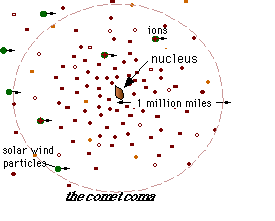The Stardust spacecraft came back to Earth in January 2006. The main spacecraft let go of the sample return capsule. The capsule re-entered Earth's atmosphere. It then used parachutes to gently land in Utah. Scientists in a helicopter picked up the capsule.
Click on image for full size
Images courtesy NASA/JPL-Caltech; animation created by Windows to the Universe staff (Randy Russell).
Stardust returns - with comet dust!
News story originally written on January 11, 2006
A spacecraft named Stardust will soon return to Earth to complete its 7 year-long
mission. Stardust flew past a comet and grabbed some pieces of dust from the
comet. The spacecraft will return those dust particles to Earth so scientists
can study them. The scientists hope to learn about comets, and about the
history of our Solar System, from the comet dust.
Stardust was launched in 1999 and flew by the comet in January 2004. It snapped
the best pictures ever of
the nucleus
of a comet as it flew past Comet Wild
2. It also grabbed some dust from the comet's
atmosphere using a high-tech
material called aerogel.
A capsule on the Stardust spacecraft will bring the comet dust back to Earth.
The capsule has a heat shield to protect it when it re-enters Earth's atmosphere.
It also has parachutes that will gently lower it to the ground. The capsule
will land in Utah at around 3 AM on January 15, 2006. After it lands, crews
in helicopters will pick up the capsule. They will take it
to
scientists
who will open the capsule and get the dust particles out. The scientists will
study the dust to learn more about comets.
You might also be interested in:

Stardust is the name of a space mission that studied a comet. NASA's Stardust spacecraft flew past a comet named Wild 2 in January 2004. During its flyby Stardust collected some dust particles from the
...more
This example of Interstellar Dust is a perfect example of the kind of rocky material that may make comets. The grains themselves seem to be made of smaller grains. There are many holes, or pores. In a
...more
Scientists believe that the solar system was formed when a cloud of gas and dust in space was disturbed, maybe by the explosion of a nearby star (called a supernova). This explosion made waves in space
...more
The picture on this page shows the best views ever of the nucleus of a comet. It shows two pictures of the comet's nucleus that were taken at slightly different times. The pictures were taken by a spacecraft
...more
Comet Wild 2 is named after the scientist who discovered it. Paul Wild is an astronomer from Switzerland who discovered the comet in January 1978. Wild 2 is pronounced "Vilt 2". The comet orbits the Sun
...more
As the ices of the comet nucleus evaporate, they expand rapidly into a large cloud around the central part of the comet. This cloud, called the coma, is the atmosphere of the comet and can extend for millions
...more
Scientists have found a type of amino acid in a sample returned from a comet. Amino acids are the building-blocks of proteins. Proteins are one of the most important types of molecules in living creatures.
...more















